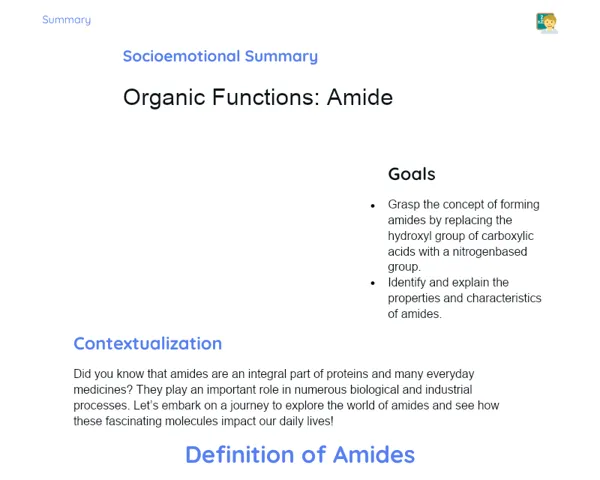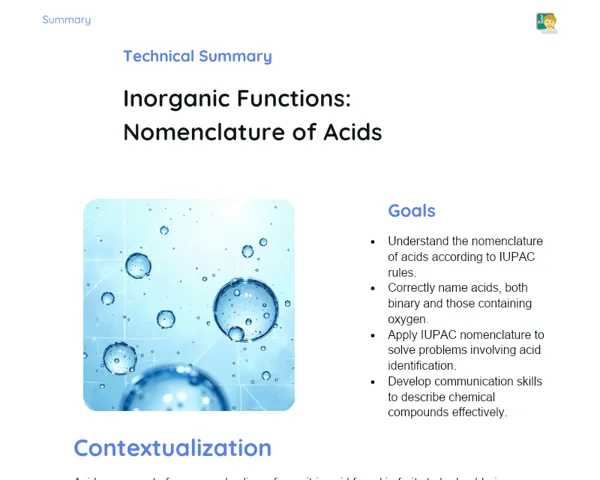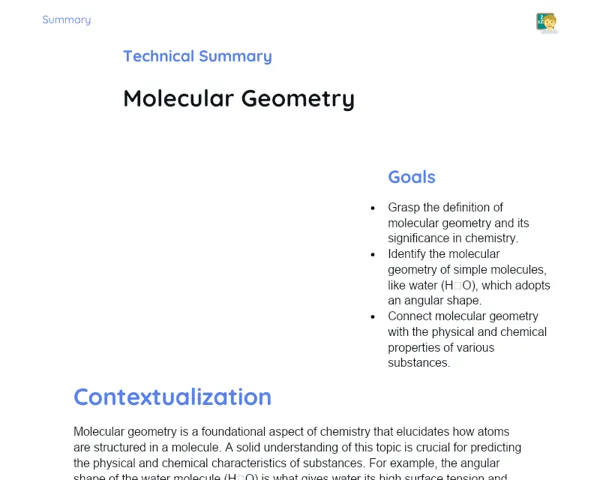Socioemotional Summary Conclusion
Goals
1. Grasp the basic ideas of stoichiometry, including how to calculate mass, volume, number of moles, and atoms.
2. Build your ability to solve stoichiometry problems, even when dealing with excess compounds and impurities in samples.
3. Apply your stoichiometry knowledge to work through practical problems, paving the way for real-life challenges in Chemistry.
Contextualization
Have you ever wondered how scientists manage to produce medicines with pinpoint accuracy or develop sustainable materials? 🌱✨ It’s thanks to stoichiometry! With it, we can calculate the exact quantities of reactants required to get the desired products without waste. Think of it like preparing your favourite mithai without the right measurements – the result just wouldn’t turn out as expected, right? 😅 Similarly, stoichiometry is our recipe in the lab, ensuring that our experiments yield the perfect outcome. Let’s explore this fascinating subject and see how these calculations connect with our everyday lives and the world around us!
Exercising Your Knowledge
Definition of Stoichiometry
Stoichiometry is a branch of chemistry that deals with the quantitative relationships between reactants and products in a chemical reaction. Imagine it as the exact recipe for your favourite dish – every ingredient (or reactant) must be measured correctly for the final product to be just right. Otherwise, you might end up with a mix-up, or in our case, a chemical disaster!
-
It studies the precise proportions of reactants and products.
-
It ensures that chemical reactions are efficient and minimise waste.
-
It helps calculate the exact amounts of substances needed to achieve the desired outcome.
Law of Conservation of Mass
The Law of Conservation of Mass states that the total mass of the reactants remains equal to the total mass of the products in a chemical reaction. In simple terms, matter is neither created nor destroyed – it only changes form. Think of it like dismantling an old toy to create something new: while the parts may be rearranged, nothing is actually lost!
-
The total mass of reactants is equal to the total mass of products.
-
It is based on the principle that matter simply transforms, rather than disappearing.
-
This concept is fundamental when balancing chemical equations.
Stoichiometric Calculations
Stoichiometric calculations allow us to determine the required or produced quantity of any substance in a chemical reaction. By using molar relationships from a balanced equation, you can figure out exactly how many grams, litres, or moles of a reactant you need to obtain a specific amount of product, or vice versa.
-
It helps calculate the exact amounts of reactants and products involved in a reaction.
-
The process is based on the molar relationships found in balanced chemical equations.
-
It is crucial for many practical applications, from manufacturing medicines to designing new materials.
Limiting Reactant and Excess Reactant
Often in chemical reactions, one reactant runs out before the others, thereby limiting the amount of product formed – this is known as the limiting reactant. The reactant that is left over after the reaction finishes is the excess reactant. Understanding these concepts can help us optimise reactions and prevent wastage.
-
The limiting reactant is the one that gets used up first in a reaction.
-
The excess reactant is what remains after the reaction has gone to completion.
-
Identifying the limiting reactant is key to determining the maximum amount of product that can be formed.
Impurities in Samples
Impurities in a sample can significantly affect stoichiometric calculations because only the pure portion of the sample reacts as expected. It’s a bit like having a box of sweets that isn’t completely uniform – you can’t count every piece as if it were an ideal, intact sweet!
-
Impurities refer to unwanted substances present in a sample that do not take part in the chemical reaction.
-
They can alter stoichiometric calculations because only the pure component reacts properly.
-
It is important to factor in the purity percentage when performing calculations to get accurate results.
Key Terms
-
Stoichiometry: The study of the quantitative relationships between the reactants and products in chemical reactions.
-
Law of Conservation of Mass: The principle that the total mass of reactants equals the total mass of products.
-
Balanced Chemical Equations: Equations that have matching quantities of each element on both sides of the reaction.
-
Limiting Reactant: The reactant that is completely used up first in a chemical reaction, limiting the amount of product formed.
-
Excess Reactant: The reactant that remains unreacted after the chemical reaction is complete.
-
Impurities: Unwanted substances in a sample that do not participate in the chemical reaction.
For Reflection
-
How did you feel when working on stoichiometry problems in a group? What emotions surfaced, and how did you manage them?
-
Can you see any parallels between understanding limiting reactants and improving efficiency in your daily tasks?
-
What similarities do you notice between balancing a chemical equation and finding emotional balance during challenging times? How could you apply these insights from class in managing your emotions?
Important Conclusions
-
Stoichiometry is vital for understanding the exact quantities of reactants and products in chemical reactions, leading to improved efficiency and reduced waste.
-
The Law of Conservation of Mass is essential for balancing chemical equations, reinforcing the idea that matter is only transformed and never lost.
-
Through stoichiometric calculations, we can precisely determine the required or produced amounts of substances, a necessity for various practical applications.
-
Grasping the concepts of limiting and excess reactants is key for optimising reactions and cutting down on waste.
-
Recognising the impact of impurities in samples is important, as they can alter the outcomes of stoichiometric calculations, emphasising the need for accuracy.
Impacts on Society
Stoichiometry plays a significant role in modern society. For example, in the pharmaceutical industry, stoichiometric calculations are fundamental to ensure that medicines are produced in the correct dosages – this avoids unwanted side effects and ensures effective treatment, thus saving lives and enhancing the quality of life. Furthermore, a clear understanding of stoichiometry supports the sustainable use of natural resources, contributing to environmental conservation.
On a personal level, mastering stoichiometry can boost students’ confidence in both their mathematical and scientific abilities, encouraging many to pursue careers in STEM (Science, Technology, Engineering, and Mathematics). This precision and efficiency in chemical calculations can also be translated into everyday practices such as managing time and resources, leading to a more organised and productive lifestyle.
Dealing with Emotions
When tackling challenging stoichiometry problems, it’s natural to feel a mix of emotions. To help manage these, try following the steps of the RULER method: First, recognize how you feel when faced with a difficult problem (maybe anxiety, frustration, etc.). Then, understand that these emotions are normal, as you are pushing your boundaries. Name these feelings – for instance, ‘I feel apprehensive because this problem seems tough.’ Next, express these emotions in a constructive way, perhaps by discussing your challenges with a colleague or fellow teacher. Finally, regulate your emotions by taking a moment to breathe deeply and focus on the next step. Remember, like in any challenging situation, it’s important to keep moving forward!
Study Tips
-
Create a list of the key concepts and formulas in stoichiometry, and review this list regularly. Using different coloured markers to highlight important points can be very helpful! 🎨📚
-
Practice a variety of stoichiometry exercises. The more problems you work through, the more confident you’ll feel with the calculations. Consider forming study groups to discuss and solve problems together. 👥🧠
-
Make use of online resources and video tutorials to strengthen your understanding. Sometimes, a visual explanation can make a big difference in grasping the concepts. 🌐🎥



